When I take the time and effort to look into the true greatness of the culture I was born and raised in, I get a glimpse of the advancement of its thought process. It was so refined that it culminated in the universal prayer ” samasta lokaah sukhino bhavantu – may all beings in all worlds be well”. It is impossible to touch this pinnacle statement of human refinement and not have gratitude well up from within.
With respect and reverence, I bow down to this Bharateeya culture that single-mindedly desires and effectively offers a practical way for peace for everyone regardless of nationality, religion, gender, color of skin, language, wealth, poverty or scholarship.
Here is a schematic about what I’m thinking of presenting in this and succeeding blogs to tell you why I feel so grateful.
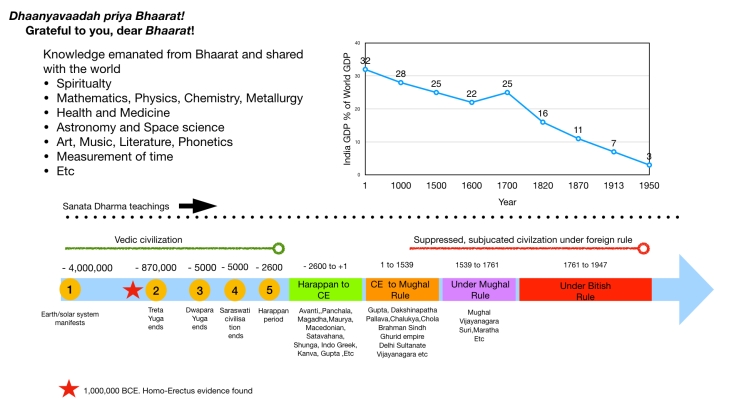
In today’s blog, I’ll share a few brief observations from the fields of modern science and vedic civilizational knowledge-base about how indeed the universe has come about.
The quest to discover, to understand and to finally know is a timeless universal thing. We all want to know stuff. Not only today but yesterday and tomorrow as well. My ancestors were also curious to explore and learn about the universe they lived in as modern scientists do. They have left behind results of their pursuits which reveal they had already discovered what the modern science is discovering today, and more.
Understanding and knowing are two different things of course. Understanding is knowledge from intellectual pursuit, is temporarily true, is limited to the confines of the boundaries drawn and assumptions made and is always riddled with doubts and uncertainty. Knowledge, on the other hand, seeks beyond the intellect, follows the heart, is permanent and is absent of all doubts.
Modern science explores in the realm of understanding whereas the vedic civilization pursued the knowledge that is the source of all understandings. Once this knowledge is known, nothing else remains to be known. To be sure, both approaches are fascinating in themselves.
A brief on what modern science has discovered till to-date
We are able to see only a tiny bit of the universe, not all of it.
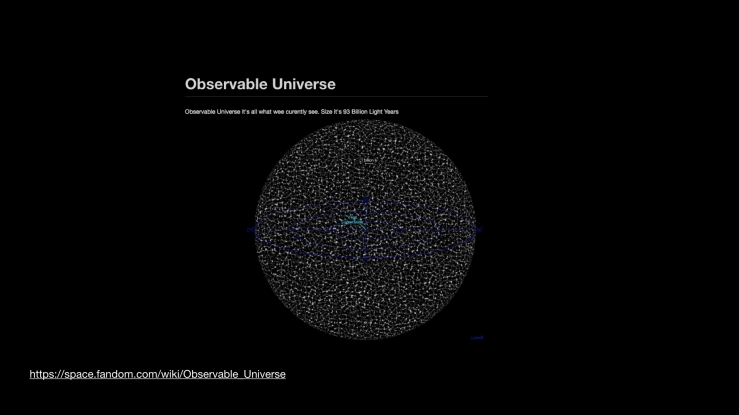
We cannot see all of the universe because the universe is expanding faster than the speed of light. That the universe is expanding was discovered in the 20th century [4]. This means when I see something in the universe, at the time I see it, what I see is no longer there at the place and time I see it. So, what is beyond what I see is something I really do not understand, let alone know.
Within the confines of this important caveat and under its constant call to humility, I’ve understood a few things about the observable patch of the universe with varying degrees of confidence.
The observable patch of the universe is a globe 94 billion light years in diameter. This is called the Hubble Volume, named after the span of vision of Hubble telescope, allowing for the rate of expansion of the universe as I’m looking at it through the telescope.
From this limited observation, I’ve deduced a few things with different degree of certainty about how the universe could have come about .
- Since the universe is expanding faster than light, what I see every time I look at it is really its past, ie how it was, not how it is.
- By “seeing the universe” I mean looking through the Hubble Telescope that is hovering 340 miles above the earth and looking at the universe unfettered by the earth’s atmosphere. Through the signals of energy received from the space (light and other forms of energy), I see a picture of a past moment in the universe.
- Since the universe is expanding, the objects are constantly moving away from each other. This means that they were closer to each other in the past than they are at the moment I see them.
- If I were to travel back sufficiently in the past (through mathematical, quantum physics and other scientific observations and calculations), to a point where all the objects were together in one place, in principle, I can arrive at the point where the observable universe began.
- Here I hit a wall, literally an opaque wall beyond which I cannot go. This is where scientific knowledge breaks down. This wall is called Cosmic Microwave Band (CMB), observed first in 1965 [4]. CMB is the constant, uniform and unchanging sound pervading the universe. I can also understand it as the constant glow of light in the universe that shines with the same intensity at all points in the universe.
- Since I cannot go beyond the CMB, I do not know the point of origin of the observable universe . I can only guess it. However intellectually mesmerizing, my guesses are – and there are several of them – they are only that – guesses, and no more. Not understandings. Not knowledge. Just guesses.
The universe came about from a “Big Bang”

The prevalent theory today is the “Big Bang” theory, proposed in 1927. The name “Big Bang” implies misleadingly that there was some kind of an explosion. But there was no “explosion”, as in a particle exploding in space at all. The Big Bang created and stretched space itself, expanding the universe. [4]
This space was dark and cold (there was no heat or light). Then, this space expanded at unimaginably blistering rate to unimaginably large size (it is still expanding). An indescribably vast and expanding space was there instantly to begin with.
Then there was initial hot, dense phase that lasted momentarily (trillionth of a trillionth of a trillionth second). This hot, dense phase was energy (energy that we measure today in four groups – gravity, weak, strong and electromagnetic all bundled together).
Then, almost simultaneously, this phase underwent Cosmic Inflation. Cosmic Inflation is a kind of repulsive gravity that pushes things apart rather than attracting them. Alan Guth proposed this concept in 1980. This unknown energy (named as Dark Energy in 1990) is mysteriously present even today and permeates throughout the universe that is causing the universe to expand.
Space then grew in size at unimaginable speed to an unimaginable size (and is still expanding). Expansion of energy into the four fundamental forces took place within a fraction of a second at unbelievable speed.
As expansion happened, there was corresponding cooling. This cooling resulted in the formation of sub-atomic particles within the first ten seconds. In the next 17-20 minutes, these sub-atomic particles combined to form protons, neutrons and nuclei.During this period, the universe was opaque.
It took next 377,000 years for the universe to cool down sufficiently and to form stable atoms. Once the atoms were formed, the universe became transparent in that light could pass through it.
First stars and galaxies were formed in about 400 million years later by the atoms combining with themselves. This is about the time water was formed also. [3]
Our earth and solar system were formed about 4.5 million years ago; first life (requiring oxygen) on earth about 3.5 million years ago.
All the matter found in the universe today – including the matter in people, plants, animals, the earth and galaxies – was created at the very first moment of time.[6]
While scientists agree on what happened after the CMB with a high degree of certainty, what happened before CMB continues to be a mystery.
Big Bang theory is not the only attempt to peek into this unknown area.
The universe came about from “literally nothing”
In 1982, Alexander Vilenkin suggested that the Universe was created by starting from “literally nothing”, meaning not only the absence of matter, but the absence of space and time as well. [5]
The universe did not come about from anything; it always was, is and will be.
Another idea from Hawking (2015) is that the universe is a self-contained entity, with no reference to anything that might have come before it. The description is timeless, In Hawking’s words, the Universe “would neither be created nor destroyed. It would just BE.”[5]
A glimpse from the vedic civilization knowledge-base
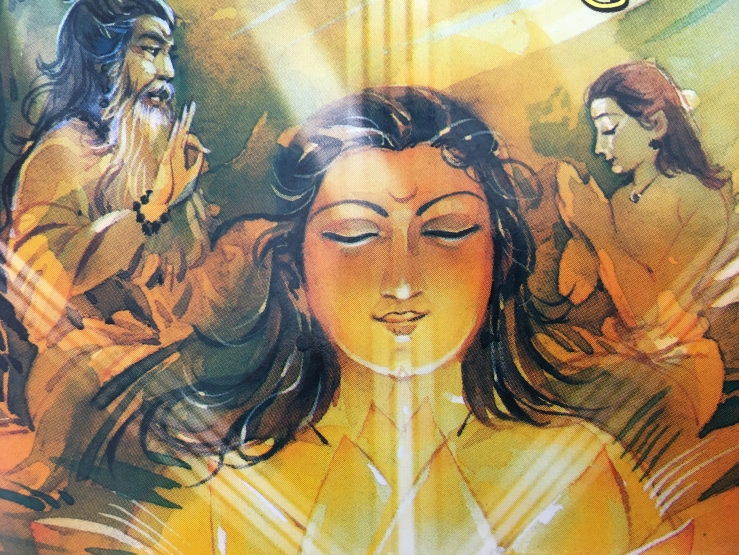 [Image credit: Sri Ramakrishna Matt, Chennai]
[Image credit: Sri Ramakrishna Matt, Chennai]
There is One Entity. This is the Truth. It is the intelligence in the intellect but is beyond the intellect. It is the imagination in the mind but is beyond the mind. It is the power in words but is beyond words. It cannot be understood by intellect, cannot be captured by mind, cannot be described by words. How the universe came about is beyond the realm of intellect and cannot be understood, but can only be known.
Here is a schematic of my limited understanding of this:
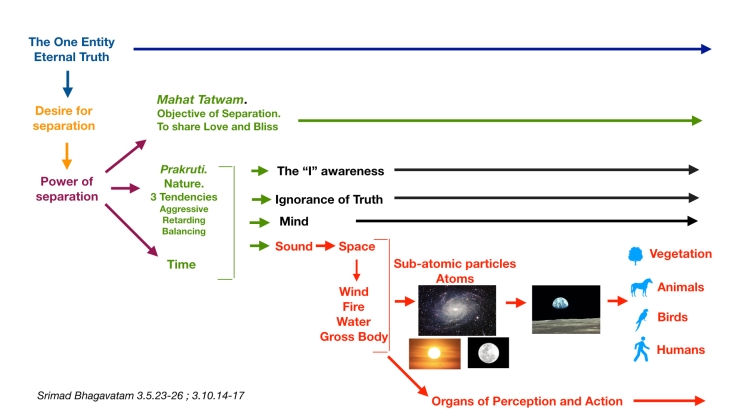
The universe is a cognizable manifestation of this One Entity.
This Entity is Love. It is Bliss. To share its Love and Bliss, the One became many by projecting Itself to appear as many.
The projection is created in two steps – primary (sargam) and secondary (visargam). Divinity is present throughout in all aspects of creation.
The primary creation has three projected categories – mahat tawam, prakruti and time.
Mahat tatwam is the operating principle for creation. It is the objective of sharing Love and Bliss.
Prakruti (Nature) is a set of three latent tendencies in absolute equilibrium with each other such that there is zero net residual tendency. The three tendencies are aggressive (rajasic), retarding (tamasic) and balancing (satwic) tendencies.
The secondary creation starts with time causing a disturbance in this equilibrium and projecting the cosmos through twenty three cosmic categories.
The sense of separation from the One Entity that is projecting Itself, the “I” sense, is created from the aggressive tendency of nature.
The sense of “mind” is projected from the balancing tendency of nature.
The subtle essence of Sound arises out of the retarding tendency of nature. From Sound, comes Space (akasa) with the quality of sound.
From Space comes the subtle essence of Touch. From the essence of Touch arises Wind with the qualities of sound and touch.
From Wind comes the subtle essence of Form (rupa). From the essence of Form arises Fire (Agni) which has the qualities of sound, touch and form.
From Form, comes the subtle essence of Taste. From the essence of Taste, comes Water carrying the qualities of sound, touch, form and taste.
From Water comes the subtle essence of Smell. From Smell comes the Gross Physical Bodies with the qualities of sound, touch, form, taste and smell.
After these five natural elements (space, wind, fire, water and gross physical matter) came the five sensory receptacles (eyes to perceive Form, ear to cognize Sound, nose to perceive Smell, tongue to cognize Taste and skin to cognize Touch) and five action-tools (eyes for seeing, ear for hearing, mouth for speaking, tool to procreate and a tool to excrete).
The five natural elements create the sub atomic particles, atomic particles, stars, galaxies, sun, moon, earth and its vegetation, animals, birds and human beings.
I perceive and interact with all this but must do so in consonance with the underlying modus operandi of the universe – to give and receive Love and Bliss.
The vedic seers did not just observe a patch of the universe to arrive at the results they did. They pursued knowledge over understanding and reached out to the One Entity that is projecting Itself as many.
How do Modern Science and Vedic Civilization knowledge-base compare?
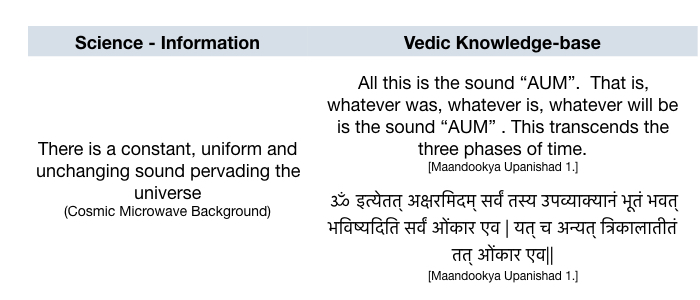
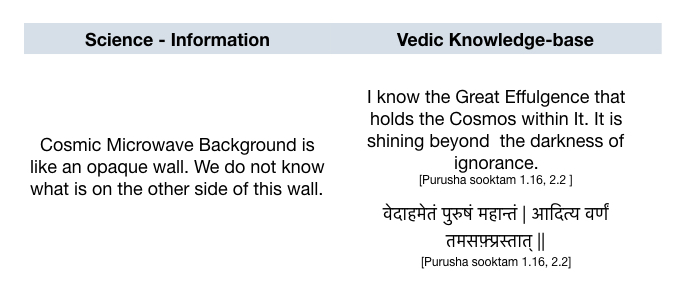
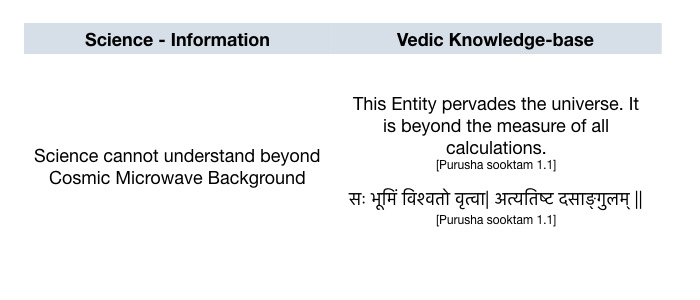

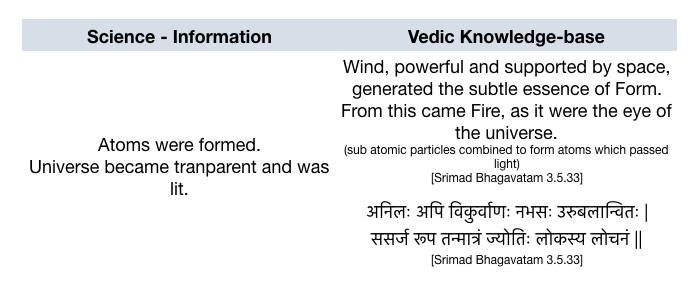
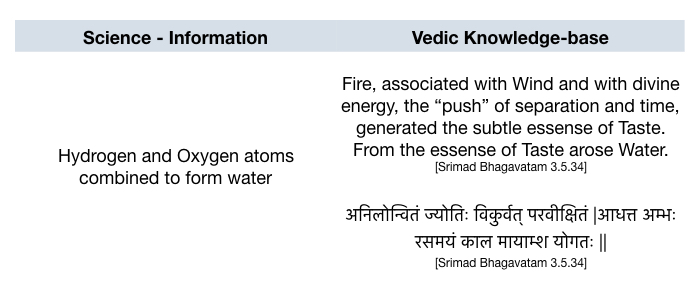

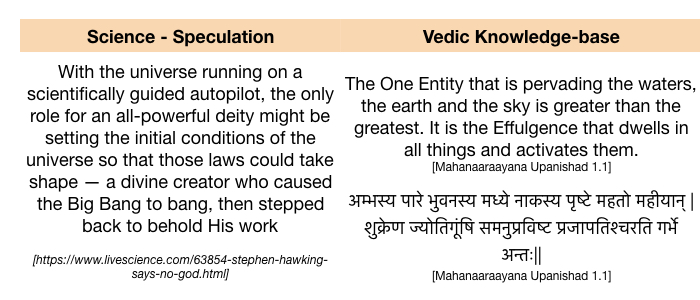

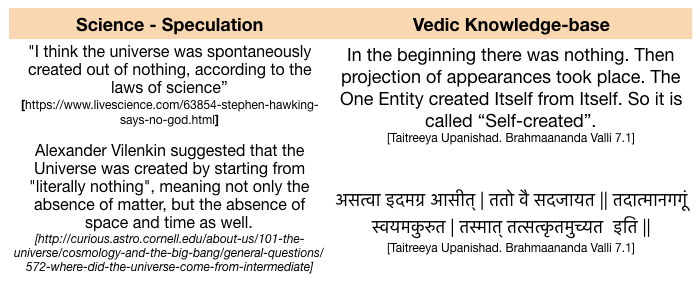
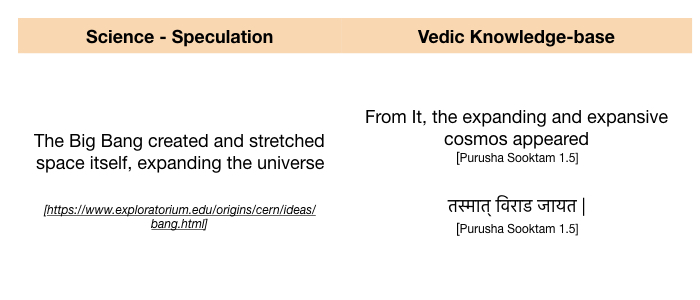

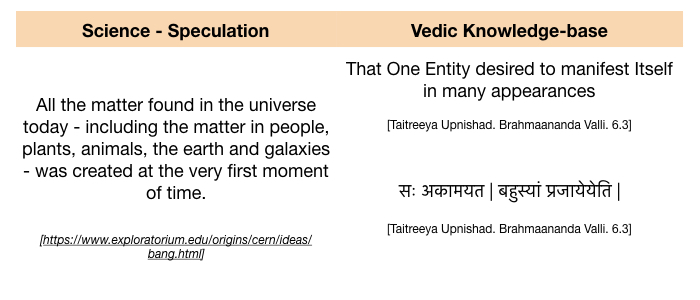
 Modern Science’s information is from the 20th and 21st centuries, a relatively recent time period in the span of human civilization on earth. The time period of Vedic civilization is conservatively estimated to be before 3000 BCE. Vedic civilization knowledge-base is at least 5000 years old if not older. I see that, even from a peep into it, that my ancestors knew already what modern science is discovering today, and more, about how the universe came about.
Modern Science’s information is from the 20th and 21st centuries, a relatively recent time period in the span of human civilization on earth. The time period of Vedic civilization is conservatively estimated to be before 3000 BCE. Vedic civilization knowledge-base is at least 5000 years old if not older. I see that, even from a peep into it, that my ancestors knew already what modern science is discovering today, and more, about how the universe came about.
Next blog: About time and birthdays
Additional references:
- https://en.wikipedia.org/wiki/Universe
- https://www.space.com/4201-greatest-mysteries-universe.html
- http://curious.astro.cornell.edu/about-us/101-the-universe/cosmology-and-the-big-bang/general-questions/572-where-did-the-universe-come-from-intermediate
- http://discovermagazine.com/2013/september/13-starting-point
- https://en.wikipedia.org/wiki/Discovery_of_cosmic_microwave_background_radiation
- https://profmattstrassler.com/articles-and-posts/relativity-space-astronomy-and-cosmology/history-of-the-universe/
- https://www.livescience.com/63854-stephen-hawking-says-no-god.html
—–



